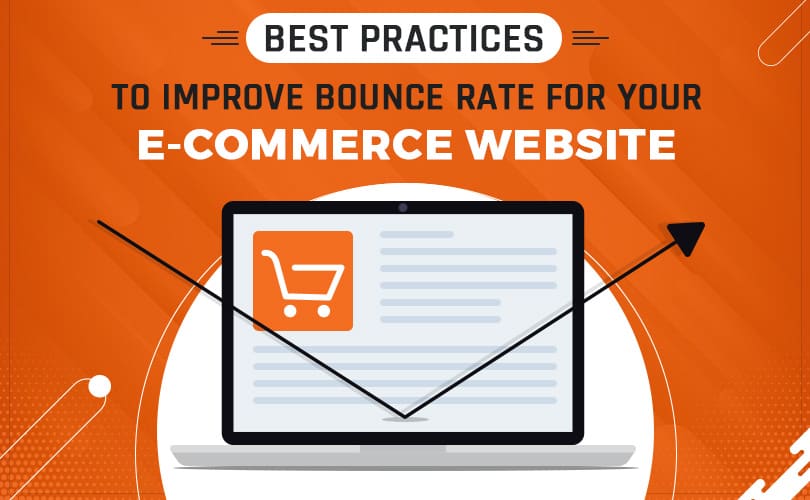


In simplest terms, bounce rate is the percentage of visitors who navigate away from your landing page without taking any action or engaging with any other part of your website. For example, let’s say 100 users visit your site on a particular day. Of those visitors, 10 went on to add a product to the cart, 45 visitors explored other pages on your website, and 10 filled out a form to request a call back from your business. The remaining 35 visitors simply left the page they landed on without taking any action at all. In this scenario, the bounce rate for your site would be 35%, since 35 out of 100 visitors took no action and left your page.
Bounce rate is an important indicator of how users are interacting with your website on a larger scale. This data can help you determine whether your website and its individual landing pages are serving their intended purpose or not.
Since bounce rate is defined as the percentage of visitors clicking off your site without taking any action, it’s safe to say that the lower the bounce rate, the better that visitors are engaging with your business. Having a bounce rate near 0 percent would obviously be ideal, but that’s honestly not a realistic expectation. Not even the almighty Amazon has a bounce rate that low!
Nevertheless, the goal should always be to find ways to reduce your bounce rate. But why does that matter? It really comes down to a simple mathematic correlation: the lower your bounce rate, the higher your conversion rate!
Let’s say you have a thousand weekly visitors, with a bounce rate of 50%. This means you have five hundred visitors taking some kind of action on your site; that’s good! But you’re also losing a lot of visitors at the same time, which isn’t so good. What would it be worth to you to be able to make some changes on your site which can reduce your bounce rate to 40%, resulting in 100 additional users taking action?
Having and maintaining a website is (or should be!) a significant investment on the part of your business. Plain and simple, working to improve your bounce rate is a smart way to provide more return on your website investment, as it enables you to generate more conversions.
So, what can you do to improve your bounce rate? We will divide the answer into two parts. The first part includes some essential factors for setting a good bounce rate bar, and the second part describes additional steps you can take to improve your bounce rate even further.
Here are some basic bounce rate determining factors you simply can’t ignore:
Your website loading speed has to be fast. A webpage should load within 2-5 seconds. The longer it takes your page to load, the less patient your users become, and the more likely they are to click off. Take the time to determine where your audience is coming from. Open your website analytics and check to see what devices and browsers they’re using to access your site, and then test your website speed across these browsers and devices. It’s also a good idea to test the site speed across different regions with a VPN. Servers can tend to have different response times in different regions.
One of the most important elements resulting in higher bounce rates is having a lack of relevant, high-quality content on your website. There has to be a match between your users’ interests and expectations, and what you’re able to provide them in terms of website content. If users don’t find what they’re looking for right away, they will promptly leave your site. It’s really as simple as that.
In order to make the website and individual web pages user-friendly, they need to be easy to navigate, with a clear organizational structure. If there’s a significant amount of text on the page, be sure to break it up into smaller, bite-sized chunks with proper headings and labels. And if your page lists a lot of products, it’s also important to divide your products by features and categories. Be sure to include a search box, and allow users to apply filters to search results – this is one of the most effective ways to enable users to find exactly what they’re looking for, quickly.
There are generally three types of devices people use to access websites: mobile phones, tablets, and computers. Even so, there are quite a few variations of screen sizes for each of these device categories. To make the browsing experience seamless for anyone who clicks onto your site, the website should be optimized to function properly on any device, of any screen size.
Once you have these basics established for your website, you can then move on to pursue some other steps to further improve your bounce rate:
Do some research to see what typical bounce rates look like in your industry, and set a bounce rate goal for your own website accordingly. The average bounce rate can vary widely by business type, location, and other key factors. Once you’re able to land on a good bounce rate target number to shoot for, then you can look further at what steps you need to take to get there.
The goal is to figure out why users are leaving without taking any actions. One practical approach to finding that out is to make use of Microsoft Clarity, or another similar user behavior analytics tool. This can provide you with user statics, heatmaps, and session recordings of visitors interacting on your website. You can dial down to focus on specific landing pages you really want to improve, and take note of all the potential areas for bounce rate improvement.
Once you’ve identified all the possible areas for page improvement, you’ll need to prioritize the proposed changes based on the predicted ROI of these improvements. Changes that are likely to improve user experience significantly should be addressed first.
In some instances, it can be hard to predict how users may respond to a specific change to your website. In these cases, it’s helpful to conduct tests of how the site performs both with and without the changes applied over a fixed amount of time. In other words, you’ll want to do some A/B testing to ascertain how a proposed change actually affects the bounce rate.
Bounce rate is one of the most important parameters when it comes to defining the quality of user experience for a website. Reducing bounce rate is a sure tactic for helping to generate more conversions on your site. But it’s also important to realize that bounce rate is just one part of the equation. You really need to look at all aspects of the user experience to make everything as relevant, easy, and seamless as possible for your site visitors.
We understand that taking on everything as a whole process can feel like a daunting task, and you may not have all the resources or the expertise to optimize your website yourself. Thankfully, the pros at Cibirix are here to help! Connect with one of our digital marketing experts today, and let’s get started!

Since founding Cibirix, Ashish has leveraged his marketing degree to lead the agency in crafting meaningful digital marketing experiences for clients. His results-driven approach is a unique mix of analytical thinking, crisp visual aesthetics and a desire to simplify frontends while developing robust architecture. With a passion for design, technology, & marketing, He leads each aspect of the agency’s business and oversees its talented team of digital professionals.